New Zealand passport
New Zealand passports (in Māori: Uruwhenua Aotearoa) are issued to New Zealand citizens for the purpose of international travel by the Department of Internal Affairs. New Zealand has a passport possession rate of around 70% of the population and there are around 2.9 million New Zealand passports in circulation.[3] It is ranked as one of the most powerful passports in the world.[4]
| |
|---|---|
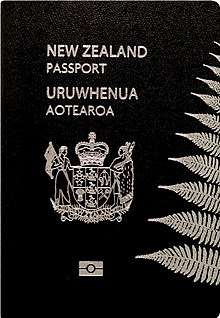 The front cover of a contemporary New Zealand biometric passport (with chip | |
| Type | Passport |
| Issued by | |
| First issued |
|
| Purpose | Identification |
| Valid in | All countries |
| Eligibility | New Zealand citizens |
| Expiration | Age at date of Application:
15-: 5 Years from Date of Issue 16+: 10 Years from Date of Issue |
| Cost | Adult (16+) (new)[1]
Adult (16+) (renewal)[1]
Child (under 16)[2]
|
History
New Zealand participates in the Five Nations Passport Group, an international forum for cooperation between the passport issuing authorities in Australia, Canada, the United Kingdom, and the United States to "share best practices and discuss innovations related to the development of passport policies, products and practices".[5]
Early 20th century: Passports introduced
Few countries required passports before the First World War, and they were not then usually required for overseas travel. By 1900 there were occasional requests for New Zealand passports, which were personally signed by the Governor. In 1905 MP George Fowlds decided to return to Scotland for his father's 100th birthday. He decided he needed a passport when his ship was about to leave; an inconvenience both for the department and the Governor who had to sign it. A single passport covered a man and his wife and children, but did not include a photo or any personal details like age, height, or eye colour.[6]
In the First World War the British Government required passports in 1915, and New Zealand followed from November 1915, with an increased workload for the department and for police. 1,108 passports had been issued in 1909, but 6,000 were issued in the nine months from 15 November 1915 to 21 August 1916. The number was kept high by civilian travel after the war, over 4,300 in 1921, and the number hovered at that level until the Depression. The number then fell from 4,722 in 1930 to 2,455 for the year ended 31 March 1934.[7]
1950s: New Zealand citizenship introduced
After the creation of modern New Zealand citizenship with the passing of the British Nationality and New Zealand Citizenship Act 1948 (which came into force on 1 January 1949), residence in New Zealand no longer qualified British or Commonwealth citizens for a New Zealand passport, and they had to apply for New Zealand citizenship then for a passport, with increased work for the Department of Internal Affairs. In 1950 the number of passports issued topped ten thousand, twice as many as were issued in 1939.[8] Between 1948 and 1977, New Zealand passports bore the words 'New Zealand citizen and British subject'.[9]
Starting on 1 July 1981, the Fraser Government announced that New Zealand citizens could no longer travel to Australia without passports, as it was felt that too many people who were not entitled to travel without passports to Australia were passing themselves off as New Zealanders.[10][11]
1990s: Machine-readable passports introduced
In 1992, the Department of Internal Affairs started issuing machine-readable passports in New Zealand, whilst New Zealand overseas posts continued to issue manual passports. Since 24 February 1992, children's names have no longer been endorsed in the passports of their parents. In February 1997, the New Zealand High Commission in London began issuing machine readable passports.[12]
In December 2000, French was removed from the biodata page of the New Zealand passport and replaced with Māori - this change was brought about by the Department of Internal Affairs to reflect the status of Te Reo Māori as an official language of New Zealand and to give "New Zealanders travelling abroad a passport that more accurately reflects their national identity".[13]
In 2001, the Department of Internal Affairs took over responsibility for the London Passport Office from the Ministry of Foreign Affairs and Trade.[14]
2000s: Non-machine-readable passports phased out
By 2003, only around 4% of all New Zealand passport holders still held a non-machine readable version.[15]
On 26 October 2004, New Zealand diplomatic posts stopped issuing manual passports and, on the same day, began issuing short-term machine-readable emergency travel documents for New Zealand citizens who need to travel urgently.[16][17] One of the reasons for reducing the number of non-machine readable passports in circulation was to increase the security of New Zealand passports; another was that, starting on this day, New Zealanders travelling to the United States under the Visa Waiver Program were required to enter on a machine readable passport.[18]
From this date onwards, all New Zealand citizens applying for a passport overseas have had to send their application to the Passport Office in New Zealand, Sydney or London. It also meant that all New Zealand passports issued on or after 26 October 2004 were machine-readable. Remaining non-machine readable New Zealand passports (M series) were still valid and expired by 25 October 2014 at the latest (only around 2% of New Zealand passport holders still had a non-machine readable version as of that date).[19]
2005: Biometric passports introduced, and validity reduced to 5 years
On 4 November 2005, the Department of Internal Affairs began issuing New Zealand biometric passports (EA series).[20] In order to cover the higher costs associated with the production of biometric passports (compared with the previous machine readable passports), the application cost increased from NZ$71 to NZ$150 for adults and from NZ$36 to NZ$80 for children.[21]
All passports issued from 24 April 2005 to 29 November 2015 - both adult and child - have a maximum passport validity of five years as a result of the Passports Amendment Act (2005). Passports that were issued prior to 24 April 2005 remained valid until the date of expiry as stated on the biodata page. From 24 April 2005, New Zealand passports were no longer endorsed with name changes, which meant that, for example, changing to a married name required applying for a new passport.
2009: New passport design introduced
On 23 November 2009, the Department of Internal Affairs launched a new (and the current) version of the biometric passport (LA series), supplied under a contract with the Canadian Bank Note Company at a cost of just under $100 million over five years. One of the motivations for a new passport design was to ensure that it would remain difficult to produce counterfeit New Zealand passports.[22] Unlike the previous biometric passport, photographs on the biodata page are now laser engraved in black and white for extra security.[23]
2014: Passport validity increased to 10 years again
On 29 May 2014, after considering the Petition of Kyle Lockwood, the Government Administration Committee recommended to the New Zealand government that ten-year passports for adults be reinstated. The committee concluded "On the evidence received, we are not convinced that the reduction in detected fraudulent passports is a result of the shorter validity period. It seems more likely to us that the introduction of biometric passports has lessened fraud and counterfeiting. The international standard among countries such as Australia, France, Germany, the United Kingdom, and the United States of America, who use similar biometric passports, is ten years. The biometric security features have led countries such as China, Canada and the Netherlands to reintroduce ten-year passports. We support the intent of the petition." [24] Law changes were passed in 2015 and since 30 November 2015, 10-year passports are available again for New Zealanders aged 16 and over; passports for children under 16 are still only valid for 5 years.
Passports issued (by year and kind)
The number of New Zealand passports and travel documents issued by year is as follows: [13] [25] [26] [27] [28] [29] [30] [31] [32] [33] [34]
| Year | Passports (standard service) | Passports (urgent service) | Emergency travel documents, refugee travel documents and certificates of identity |
|---|---|---|---|
| 2012-13 | |||
| 2011-12 | |||
| 2010-11 | |||
| 2009-10 | |||
| 2008-09 | |||
| 2007-08 | |||
| 2006-07 | 398,040 | ||
| 2005-06 | 385,966 | ||
| 2004-05 | 411,986 | ||
| 2003-04 | 390,419 | ||
| 2002-03 | |||
| 2001-02 | |||
| 2000-01 | |||
| 1999-00 | |||
| 1998-99 | |||
Entitlement to a passport
Only New Zealand citizens are entitled to be issued New Zealand passports, however, other travel documents are available from the Department of Internal Affairs for New Zealand refugees or residents who are unable to obtain passports from their home countries but need to travel; see New Zealand Refugee Travel Document and New Zealand Certificate of Identity.
Types
| Type | Usage | Front Cover Image | Biodata Page Image |
|---|---|---|---|
| Ordinary | Issued to New Zealand Citizens for ordinary travel, such as holidays and business trips. |  New Zealand Ordinary Passport cover |
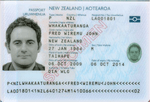 New Zealand Ordinary Passport Biodata page |
| Diplomatic [35] | Issued to New Zealand diplomats, top ranking government officials and diplomatic couriers.
Note: Holders of a diplomatic / official passport must use their ordinary passport if their travel is for non-official / diplomatic reasons.[36] |
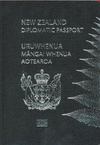 New Zealand Diplomatic Passport cover |
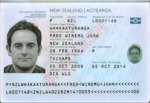 New Zealand Diplomatic Passport biodata page |
| Official | Issued to individuals representing the New Zealand government on official business.
Note: Holders of a diplomatic / official passport must use their ordinary passport if their travel is for non-official / diplomatic reasons.[36] |
 New Zealand Official Passport cover |
 New Zealand Official Passport biodata page |
| Emergency Travel Document | Issued for urgent travel only. | 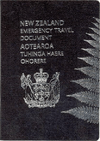 New Zealand Emergency Travel Document cover |
 New Zealand Emergency Travel Document biodata page |
| Certificate of Identity | Issued for alien residents of New Zealand who are unable to obtain a national passport. | 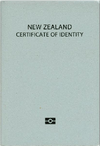 New Zealand Certificate of Identity cover |
 New Zealand Certificate of Identity biodata page |
| Refugee Travel Document | Issued for recognised refugees in New Zealand. |  New Zealand Refugee Travel Document cover |
 New Zealand Refugee Travel Document biodata page |
Obtaining a passport
Application procedure
The Department of Internal Affairs is responsible for issuing New Zealand passports. The Department of Internal Affairs issues passports from its offices in Auckland, Christchurch and Wellington in New Zealand, as well as overseas offices in Sydney and London. New Zealand embassies, High Commissions and consulates outside of Sydney and London are not able to issue passports, although diplomatic officers may be able to provide application forms and assist in communicating with an issuing office.
Adult passports now can be applied through online for both first time and renewals. Standard processing time is up to 10 working days plus delivery, unless an urgent or call-out service is requested. There are online fees for Australia and the UK as well as New Zealand.
As of January 2020, a standard passport costs $191 for adults and $111 for children, including delivery within New Zealand. [37]
Urgent travel
In emergencies, some New Zealand embassies, High Commissions and consulates may be able to issue an Emergency Travel Document with a validity of only one year intended to assist New Zealand citizens who do not have the time to obtain a passport in time to travel. An application for a New Zealand Emergency Travel Document (ETD) costs NZ$350 and includes the fee for a full replacement passport before the expiration of the ETD.[38] In countries where there is no New Zealand diplomatic post, New Zealand citizens who need to travel urgently and whose passport has expired, been lost or been stolen can be issued with an Emergency Travel Document at a cost of £95 by a British foreign mission as long as this has been cleared with the New Zealand Ministry of Foreign Affairs and Trade.[39]
Endorsement indicating New Zealand citizenship
As an alternative to obtaining a New Zealand passport, New Zealand citizens with another nationality and a foreign passport/travel document can apply for an endorsement indicating New Zealand citizenship from Immigration New Zealand (INZ). The endorsement can either be physically affixed inside the foreign passport/travel document or can be electronically linked in INZ's database to the foreign passport/travel document. An endorsement indicating New Zealand citizenship is valid for the duration of the foreign passport/travel document it is endorsed in or electronically linked to. An endorsement indicating New Zealand citizenship costs NZ$130 for first time applications and NZ$80 for subsequent applications, which means that it is cheaper than obtaining a regular adult New Zealand passport. The fee for the endorsement is completely waived if electronically linked to or affixed inside a passport issued by Austria, Finland, Greece, Iceland, Israel, Italy or Turkey.[40] Given that the maximum validity of New Zealand passports is 10 years for adults and 5 years for under 16 year olds, an endorsement indicating New Zealand citizenship may work out to be an even more economic option if affixed inside or linked electronically to a foreign passport/travel document which has a longer validity (e.g. 10 years). It is also easier to obtain an endorsement indicating New Zealand citizenship than a New Zealand passport overseas, since an endorsement can be issued at INZ offices in Apia, Bangkok, Beijing, Ho Chi Minh City, Hong Kong, Jakarta, London, Moscow, Mumbai, New Delhi, Nuku’alofa, Pretoria, Shanghai, Singapore, Suva, Sydney and Taipei, whilst New Zealand passports are only issued overseas by the Department of Internal Affairs in Sydney and London. However, New Zealand citizens with dual/multiple nationality travelling on a passport/travel document issued by another country may be unable to access New Zealand consular assistance whilst overseas and may not be able to enjoy as many visa exemptions. For example, a dual New Zealand and Samoan citizen travelling only on a Samoan passport with an endorsement indicating New Zealand citizenship affixed inside is unable to obtain a Special Category Visa (SCV) upon arrival in Australia and must obtain an Australian visitor visa before travelling, since to obtain an SCV a New Zealand citizen must present a valid New Zealand passport.
Return travel to New Zealand without a passport
In general, to establish his/her right to enter New Zealand, a New Zealand citizen is required to present a valid New Zealand passport or a passport issued by another country that is electronically linked or physically affixed with an endorsement indicating New Zealand citizenship.
However, a New Zealand embassy, high commission or consulate or an Immigration New Zealand branch can request that the immigration officer at a port of entry in New Zealand not demand to see a passport of a New Zealand citizen in urgent or compassionate circumstances (e.g. death or serious illness) where there is not enough time for a New Zealand passport to be issued.[41]
Physical appearance
Cover
The current version of New Zealand passports issued since November 2009 are black, with the New Zealand coat of arms emblazoned in silver in the centre of the front cover. The words "NEW ZEALAND PASSPORT" and "URUWHENUA AOTEAROA" are inscribed above the coat of arms in silver. The standard biometric symbol appears at the bottom of the front cover. Both the front and back covers have silver ferns embossed on the outside edge.
Regular passports issued prior to November 2009 had a navy blue cover.
Passport note
Passports contain a note from the issuing state that is addressed to the authorities of all other states, identifying the bearer as a citizen of that state and requesting that he or she be allowed to pass and be treated according to international norms. The note inside New Zealand passports states:
- The Governor-General in the Realm of New Zealand requests in the Name of Her Majesty The Queen all whom it may concern to allow the holder to pass without delay or hindrance and in case of need to give all lawful assistance and protection.
and in Māori:
- He tono tēnei nā te Kāwana-Tianara O te Whenua o Aotearoa i raro i te Ingoa o Kuini Erihāpeti ki te hunga e tika ana kia kaua e akutōtia, e whakakōpekatia te tangata mau i te uruwhenua nei i ana haere, ā, i te wā e hiahiatia ai me āwhina, me manaaki.
Languages
The textual portions of New Zealand passports are printed in both English and Māori. (Previously English and French.)
Biodata page
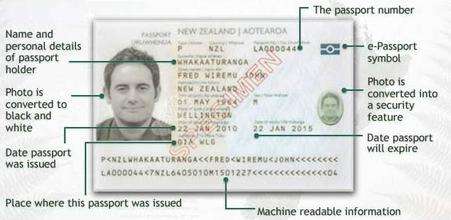
The biodata page of the current version of the New Zealand passport includes the following data:
- Photo of the passport holder (in black and white)
- Type (Momo): P
- Issuing state (Whenua): NZL
- Passport No. (Tau Uruwhenua)
- Surname (Ingoa whānau)
- Given names (Ingoa āke)
- Nationality (Iwi tūturu): NEW ZEALAND
- Date of birth (Rā whānau)
- Sex (Tāne-Wahine)
- Place of birth (Wāhi whānau) (Passports issued after December 2005 will only include the city of birth)
- Date of issue (Rā timatanga)
- Date of expiry (Rā mutunga)
- Authority (Te Mana Tuku)
The information page ends with the Machine Readable Zone.
Law
Under the Passports Act 1992, the Minister of Internal Affairs has the power to refuse a passport, for example, on grounds of national security.
The Minister also has the discretion to issue a passport for less than the current ten-year validity period.
Incidents
Use by Israeli government
In 2004, two Israelis, suspected agents working for Mossad, Eli Cara and Uriel Kelman, were convicted and jailed for attempting to obtain New Zealand passports by submitting fraudulent applications. A third suspected Mossad agent, Zev William Barkan, who was a former Israeli diplomat based in Europe was involved in stealing the identity of a tetraplegic Auckland resident to obtain a passport fraudulently in his name.[42] It was not until a year later that the Israeli government formally apologised to the New Zealand government for the actions of its citizens.
In the immediate aftermath of the 2011 Christchurch earthquake, concerns were raised that a group of Israelis may have again been attempting to fraudulently obtain New Zealand passports,[43][44] but scant evidence of this has been found to-date.[45][46]
After Ofer Mizrahi, an Israeli national, died after being crushed by falling masonry in a parked van, he was found in possession of more than one foreign passport[44] and the New Zealand government investigated whether he and his companions had links to Mossad.[47] There were concerns that the travellers may have been trying to infiltrate the police national computer system to gain access to information which could be used to clone New Zealand passports.[43]
His surviving travelling companions, Michal Fraidman, Liron Sade and Guy Jordan, met with Israeli officials and left New Zealand within twelve hours of the earthquake.[45] After investigations by the police and SIS, Prime Minister Key said that they found Mossad was not involved, and that: "There is, in the view of those agencies, no link between those individuals and Israeli intelligence agencies. There was no evidence found to suggest there were anything other than backpackers".[48]
Visa requirements
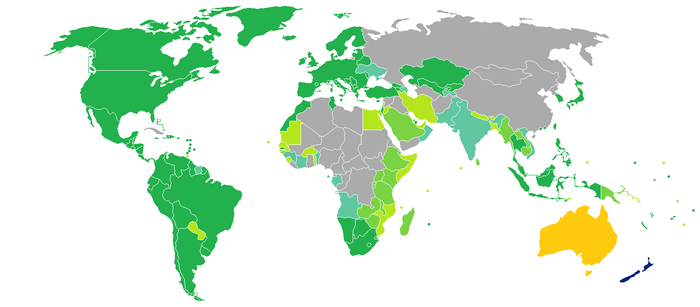
As of 26 March 2019, New Zealand citizens had visa-free or visa-on-arrival access to 181 countries and territories around the world, including all European Union member states, ranking the New Zealand passport 9th in the world in terms of travel freedom (tied with Australian and Icelandic passport) according to the Henley Passport Index.[49] Additionally, Arton Capital's Passport Index ranked the New Zealand passport 6th in the world in terms of travel freedom, with a visa-free score of 162 (tied with Icelandic and Maltese passports), as of 2 December 2018.[50]
Foreign travel statistics
According to the statistics these are the numbers of New Zealand visitors to various countries per annum in 2015 (unless otherwise noted):
- Data for 2017
- Counting only guests in tourist accommodation establishments.
- Data for 2016
- Data for 2013
- Data for arrivals by air only.
- Data for 2012
- Data for 2014
- Data for 2009
- Data for arrivals by air only.
- Total number includes tourists, business travelers, students, exchange visitors, temporary workers and families, diplomats and other representatives and all other classes of nonimmigrant admissions (I-94).
Previous Passports
- First New Zealand photo identification passport type issued between c. 1915 and 1923.
- Interior of the first type of photo I.D New Zealand passport. This fold-out sort was replaced by the familiar booklet form around 1923, some time after the type had been phased out in most other parts of the British Empire.
 New Zealand passport issued in 1949
New Zealand passport issued in 1949- Third type of New Zealand passport which superseded the 'Dominion of New Zealand' type 2. Used through the 1950s and 1960s and replaced in 1973.
.jpg) An example of a diplomatic passport from 1952
An example of a diplomatic passport from 1952_(1952).jpg) Interior of a 1952 issued diplomatic passport
Interior of a 1952 issued diplomatic passport New Zealand biometric passport issued between November 2005 and November 2009
New Zealand biometric passport issued between November 2005 and November 2009
See also
References
- Bassett, Michael (1997). The Mother of All Departments: The history of the Department of Internal Affairs. Auckland: Auckland University Press. ISBN 1-86940-175-1.CS1 maint: ref=harv (link)
- "Passport costs | New Zealand Passports". www.passports.govt.nz.
- "Passport costs | New Zealand Passports". www.passports.govt.nz.
- Online Passport Renewal Service (ORS)
- "Revealed: The world's most powerful passports". The Telegraph. Retrieved 27 December 2016.
- "International Comparison". 18 September 2011. Archived from the original on 18 September 2011.
- Bassett 1997, p. 57.
- Bassett 1997, p. 75, 97.
- Bassett 1997, p. 150.
- Walker, W.; Taonga, New Zealand Ministry for Culture and Heritage Te Manatu. "New Zealand issues its own passports". teara.govt.nz.
- "Department of Internal Affairs Annual Report 1996-1997" (PDF).
- "Department of Internal Affairs Annual Report 2000-2001" (PDF).
- "Department of Internal Affairs Annual Report 1999-2000" (PDF).
- "US offers more time for new passport rules". 9 September 2003 – via www.nzherald.co.nz.
- Trade, New Zealand Ministry of Foreign Affairs and. "Embassies". New Zealand Ministry of Foreign Affairs and Trade.
- TVNZ: Government introduces e-passport
- above, Helen TunnahFor a graphic detailing the new passports, click on 'more pictures' (3 November 2005). "Microchips in passports double price" – via www.nzherald.co.nz.
- "New style ePassport released today | Scoop News". www.scoop.co.nz.
- "World". 1 NEWS.
- "Petition 2011/97 of Kyle Lockwood - New Zealand Parliament". www.parliament.nz.
- "Department of Internal Affairs Annual Report 2012-2013" (PDF).
- "Department of Internal Affairs Annual Report 2011-2012" (PDF).
- Department of Internal Affairs Annual Report 2010-2011
- "Department of Internal Affairs Annual Report 2009-2010" (PDF).
- Department of Internal Affairs Annual Report 2008-2009
- Department of Internal Affairs Annual Report 2006-2007
- Department of Internal Affairs Annual Report 2004-2005
- "Department of Internal Affairs Annual Report 2003-2004" (PDF).
- "Department of Internal Affairs Annual Report 2002-2003" (PDF).
- Department of Internal Affairs Annual Report 1998-1999
- "Ministerial Office Handbook; see" (PDF).
- "Passport Costs". Passport Office, Department of Internal Affairs.
- "Urgent travel | New Zealand Passports". www.passports.govt.nz.
- Foreign & Commonwealth Office: The new UK Emergency Passport
- Immigration New Zealand: Fees Guide (Note that although Japan is listed, in practice in most cases this will not apply as Japan has restrictive rules relating to dual nationality.)
- http://www.immigration.govt.nz/opsmanual/i35031.htm
- Chapman, Paul (20 July 2011). "Neutral New Zealand passports highly prized by overseas intelligence" – via www.telegraph.co.uk.
- "Earthquake unmasked team of Israeli spies in New Zealand". Mail Online. 21 July 2011.
- "New Zealand". 1 NEWS.
- Gower, Patrick (20 July 2011). "Israeli backpacker demands apology for spy debacle". Newshub. Retrieved 8 May 2017.
- "Israelis 'likely an official covert team'". Stuff.
- "Israeli ambassador refuses to answer questions" – via www.newshub.co.nz.
- "Global Ranking - Visa Restriction Index 2019" (PDF). Henley & Partners. Retrieved 31 March 2019.
- "Global Passport Power Rank | Passport Index 2020". Passport Index - All the world's passports in one place.
- https://www.corporate.southpacificislands.travel/wp-content/uploads/2017/02/2017-AnnualTourist-Arrivals-Review-F.pdf
- "Statistical Yearbook - Department of Commerce". Archived from the original on 11 February 2017. Retrieved 9 February 2017.
- Anuário de Estatística do Turismo
- "Tourism Statistics - IAATO". iaato.org.
- Tourism Statistics for Antigua and Barbuda
- "Archived copy" (PDF). Archived from the original (PDF) on 14 February 2017. Retrieved 30 May 2017.CS1 maint: archived copy as title (link)
- "Number of foreign citizens arrived to Azerbaijan by countries".
- Stopovers by Country, table 34
- https://corporate.visitbarbados.org/wp-content/uploads/2017/12/2016-annual-statistical-report.pdf
- "Tourisme selon pays de provenance 2016". Archived from the original on 20 August 2017. Retrieved 20 August 2017.
- Estadísticas por Actividad Económica. Turísmo
- "TOURISM STATISTICS Cumulative data, January – December 2016" (PDF). Retrieved 3 March 2017.
- Tourism Statistics Annual Report 2015
- http://dadosefatos.turismo.gov.br/2016-02-04-11-53-05/item/download/784_28e96970a52eb457d54bb9c5f454029a.html
- Tourism Statistics Report
- "Service bulletin International Travel: Advance Information" (PDF). statcan.gc.ca.
- Air Visitor Arrivals - Origin & General Evolution Analysis
- Most important countries of origin of foreign tourists in China in 2016
- The data obtained on request. Ministerio de Comercio, Industria y Turismo de Colombia Archived 6 June 2017 at the Wayback Machine
- Anuario de Turismo
- TOURIST ARRIVALS AND NIGHTS IN 2017
- ARRIVALS OF TOURISTS BY COUNTRY OF USUAL RESIDENCE
- 2015 Visitors Statistics Report
- "Archived copy". Archived from the original on 16 April 2016. Retrieved 2 April 2016.CS1 maint: archived copy as title (link)
- Nombre de touristas
- "International arrivals 2017".
- Tourismus in Zahlen 2015, Statistisches Bundesamt
- "Archived copy" (PDF). Archived from the original (PDF) on 5 October 2018. Retrieved 22 May 2016.CS1 maint: archived copy as title (link)
- Market research and statistics
- TOURIST ARRIVALS TO ISRAEL (EXC. DAY VISITORS & CRUISE PASSENGERS) BY NATIONALITY, Ministry of Tourism
- Monthly Statistical Report December 2017 Vol xxvii No 12
- - 2015 Foreign Visitors & Japanese Departures, Japan National Tourism Organization
- Tourist Overnight and Same Day Visitors By Nationality during
- Туризм Казахстана. 2.4 Количество посетителей по въездному туризму
- Visitor Arrivals by Country of Residence - Tarawa only Archived 19 March 2016 at the Wayback Machine
- "Statistical Reports on Tourism in Laos".
- Arrivals according to nationality during year 2016
- Visitor Arrivals
- "Archived copy". Archived from the original on 6 January 2017. Retrieved 5 January 2017.CS1 maint: archived copy as title (link)
- "TOURIST ARRIVALS TO MALAYSIA BY COUNTRY OF NATIONALITY DECEMBER 2017" (PDF). Archived from the original (PDF) on 5 March 2018. Retrieved 7 March 2018.
- Number of visitors by country, 2009
- http://www.tourism.gov.mv/packages/december-2017/
- ANNUAIRE 2014 (by residence)
- "Archived copy". Archived from the original on 1 October 2016. Retrieved 22 October 2016.CS1 maint: archived copy as title (link)
- Table 4. Foreign tourist arrivals and overnight stays by countries, 2014
- "Archived copy". Archived from the original on 14 July 2017. Retrieved 14 October 2017.CS1 maint: archived copy as title (link)
- Tourism Statistics 2015 p.32 Archived 31 January 2017 at the Wayback Machine
- "Visitors arrival by country of residence and year".
- Number of Tourists to Oman
- Estadistica de Turismo – Turistas internacionales, según país de residencia permanente
- "Archived copy" (PDF). Archived from the original (PDF) on 10 February 2018. Retrieved 7 March 2018.CS1 maint: archived copy as title (link)
- "Въезд иностранных граждан в РФ". Fedstat.ru. 18 October 2017. Retrieved 18 October 2017.
- Tourist turnover - December 2017
- "Archived copy". Archived from the original on 22 January 2017. Retrieved 22 May 2016.CS1 maint: archived copy as title (link)
- "Archived copy". Archived from the original on 1 February 2018. Retrieved 17 April 2020.CS1 maint: archived copy as title (link)
- Visitor Statistics, 2015-2017
- "TOURIST ARRIVALS BY COUNTRY OF RESIDENCE 2017" (PDF).
- "Suriname Tourism Statistics" (PDF). www.surinametourism.sr. Archived from the original (PDF) on 12 June 2018. Retrieved 8 June 2018.
- Visitor Arrivals by Nationality
- "The 2016 International Visitors' Exit Survey Report. International Tourist Arrivals. p. 73-77" (PDF). nbs.go.tz/. NBS Tanzania. Retrieved 18 December 2017.
- International Tourist Arrivals to Thailand By Nationality 2016 Archived 18 February 2017 at the Wayback Machine
- NUMBER OF ARRIVING-DEPARTING VISITORS, FOREIGNERS AND CITIZENS December 2017
- Migration - Visitors by nationalities
- "Foreign citizens who visited Ukraine in 2017 year, by countries".
- "Annual estimates on visits and spending in the UK by overseas residents, by purpose and region of visit". Office of National Statistics.
- Includes New Zealand, Cook Islands, Tokelau, and Niue.
- Yearbook of Immigration Statistics
- International visitors to Viet Nam in December and 12 months of 2017
- "Tourism Statistical Digests". Archived from the original on 1 July 2016. Retrieved 23 May 2016.
- "Tourism Trends and Statistics Annual Report 2015". Archived from the original on 21 December 2016. Retrieved 11 December 2016.
External links
| Wikimedia Commons has media related to Passports of New Zealand. |
- Department of Internal Affairs: New Zealand Passports Services
- Images of a 1949 New Zealand passport from www.passportland.com